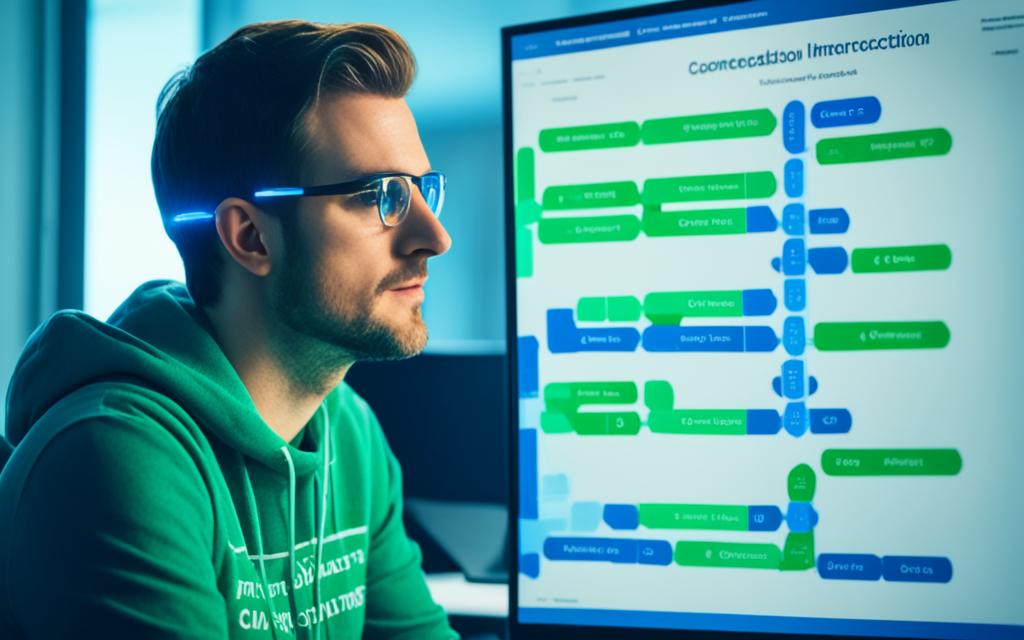Table of Contents
Blockchains are like public ledgers that let anyone see transaction history and blockchain records. They focus on being transparent. This gives a view of every transaction made. With block explorers, it’s easy to find and understand your transaction history.
Important things to look at in transaction history are the Transaction ID and the addresses of the sender and receiver. These show who’s involved. You also see the fees and the status of each transaction. This helps keep track of your transactions as they happen.
Different block explorers are available for various blockchain networks. They help users look at different cryptocurrencies. For instance, Bitcoin users can check out Blockstream and blockchain.com. Ethereum users have Etherscan. XRP transactions can be viewed with XRP Charts and Bithomp. This shows the variety in the blockchain world and the tools available1.
Fees in cryptocurrency go to network validators, showing the business side of blockchains. But, things like transaction batching let exchanges combine transactions. This lowers fees and makes things more efficient. Blockchain tech keeps updating to deal with size and cost issues1.
Platforms such as Ledger Live make it easier for users. They include blockchain explorers for each transaction. This means you can easily check on transaction details. Ledger Live connects with blockchains to give you updates on your transactions and account balance. This makes users feel at ease and ensures the system stays transparent1.
Bitcoin has a unique idea called change addresses. Any leftover money from a Bitcoin transaction goes to a change address. This keeps the transaction smooth. It shows a distinctive feature of Bitcoin compared to other digital currencies1.
Checking transactions is vital in the blockchain world. Block explorers give direct access to transaction details. This lets users make sure their digital assets are real and transparent. It puts financial control back in the hands of individuals, respecting the decentralized nature of blockchains1.
Key Takeaways
- Blockchains let everyone see transaction and blockchain history, stressing transparency and honesty.
- The essential parts of blockchain transactions are the Transaction ID, sender and receiver addresses, fees, and transaction state.
- There are several block explorers for various blockchain networks, giving users a lot of choices to look at different cryptocurrencies.
- Cryptocurrency transactions require fees that go to network validators, underlining the business side of blockchain activities.
- Services like Ledger Live integrate blockchain explorers, improving user interaction and offering real-time monitoring.
Learning to view transaction history on a blockchain and use block explorers helps users navigate digital asset worlds confidently. This ensures financial transactions are clear and secure. Keep following to learn more about blockchain tech and how it’s changing different fields.
The Transparency of Blockchains and the Importance of Verifying Transactions
Cryptocurrencies, including Bitcoin, use transparent blockchains for everyone to see. This is unlike normal finance systems. Blockchain tech keeps a complete record on a public ledger, which anyone can check. This ensures openness and the chance to confirm every deal.
This open nature is key for those involved in blockchains. Checking transactions makes people trust the system more. Users can look at the blockchain to see their crypto assets. And they can make sure what others say about their deals is true. This step prevents fraud and false news.
The clearness of blockchains is also critical for different sectors. It helps businesses fight counterfeit goods and scams. Tracking deals through a see-through blockchain tip-offs a product’s journey. This proves its origin at every part, making sure it’s real and tracked2.
The food chain also wins from blockchain’s openness. It makes spotting sources of contamination quick. This decreases waste and makes food safer and fresher. Plus, banks find it easier to work with global trades, loans, and more thanks to blockchain2.
In health, blockchains make patient files safer and sharing easy among medical staff. And in drug making, it tracks medicines from start to sale. This stops fake drugs and helps in swift recalls2.
Governments use blockchains for safer data between their people and offices. This ensures everyone follows the rules and makes contracts and public help better2. Insurers use it to handle policies and payments better, cutting down on cheats2.
Cybersecurity parties benefit from blockchain’s built-in guard against hacks and scams. The clear blockchain keeps private data safe with strong codes. It also helps make sure deals are right without mistakes3. And this tech also improves how things move in the supply chain, showing where items are at any time3.
To wrap up, blockchain’s clear setup and chance to check deals are crucial in its world. They bring trust in the system and give many fields ways to improve. As more businesses, governments, and people use blockchain’s openness, they can discover its great uses.
Using Block Explorers to Check Blockchain History
Block explorers are super useful for anyone into cryptocurrencies and blockchain. They let you look into blockchain transactions and check what’s happening. This helps you see where funds are moving and find out key info about transactions or addresses.
In 2009, when Bitcoin started, so did block explorers4. At first, they were basic sites like Block Explorer and Blockchain.info, helping people see Bitcoin transactions4. Now, you can check transactions on various networks, thanks to explorers that work with Ethereum, Litecoin, and more4.
Say you want to know more about a transaction. Just input its ID or address in a block explorer4. You’ll see who sent the money, who got it, and any fees paid. This is great for making sure transactions are safe and legit4.
Block explorers also make it easy to search through blockchain data4. They use a special kind of language, SQL, to pull out info quickly. Plus, many of them have APIs for developers to use4.
To really get into blockchain data, block explorers are key. They help you look at network activities and history4. This lets you make smart choices and adds a layer of transparency to how these networks work.
Block explorers are crucial in the world of cryptocurrencies4. They let you see transactions as they happen and understand complex networks. With these tools, both individuals and businesses can stay on top of the latest in the blockchain world.
| Popular Block Explorers for Bitcoin | Popular Block Explorers for Ethereum |
|---|---|
| blockexplorer.com | etherscan.io |
| blockchain.com | ethplorer.io |
| blockcypher.com | blockchair.com/ethereum |
| btc.com |
These are some of the top block explorers for Bitcoin and Ethereum5. They let you do lots of things like track transactions and check smart contracts. If you’re into crypto, they’re a must-have for understanding what goes on in the blockchain world.
“Blockchain explorers empower users to verify the legitimacy of transactions and conduct due diligence, enhancing transparency within decentralized networks.” – Shardeum.org
The Importance of Verifying Transactions
Block explorers are all about making blockchain transactions transparent4. They help you make sure that your digital money moves safely and correctly. This is key to avoiding scams and keeping the blockchain secure.
- Shardeum.org – Blockchain Explorer Blog
- Trust Wallet – How to Use a Blockchain Explorer
- Crypto.com – What are Block Explorers?
Popular Block Explorers for Different Cryptocurrencies
There are many block explorers for different cryptocurrencies. They show details like transactions and network data. This makes the blockchain more clear and reliable. Now, let’s dive into some popular ones.
Bitcoin Block Explorers
For those into Bitcoin, Blockstream and blockchain.com are great. They tell you all about Bitcoin moves, who’s sending money, and show blocks in an easy way. So, you can better understand how Bitcoin works.
Ethereum Block Explorer
Ethereum fans usually head to Etherscan for checking things. It helps you look up transactions, see smart contracts, and follow block stories. It keeps you updated on the Ethereum network.
XRP Block Explorers
For XRP fans, XRP Charts and Bithomp are key. They zoom in on XRP moves and network actions with detailed info and visuals. It helps XRP users keep an eye on their coins.
For anyone using these cryptocurrencies, block explorers are a must. They give you deep insights, on-time data, and easy search tools. This all makes understanding the blockchain world easier and more fun.

Want to know more about top blockchain explorers? A detailed article covers the best opens-source ones for different cryptocurrencies.
Also, for extra info on blockchain explorers, check out coinledger.io and shardeum.org. They talk about what these tools can do.
“Bitquery Blockchain Explorer offers data on 40+ chains”6
Understanding Blockchain Transaction Details
Looking at a blockchain transaction shows us key information. Blockchain technology7 has changed many areas like DeFi, NFTs, and Web3. It has proven useful beyond just cryptocurrencies. The way data is handled is very important in today’s digital age. Big companies deal with huge amounts of data7 every day.
Blockchain data is the details of transactions kept on the blockchain network. It offers openness and is available to all7. This data is on every node’s ledger, making it secure and unalterable7. Using blockchain for data analytics means managing data in a trustworthy, safe way7.
When exploring blockchain transactions, block explorers are key. They let users see past transactions on the blockchain. You can check on balances, transaction histories, and more7. Sites like blockchain.com and Etherscan give crucial details like the transaction’s ID, who sent it, the fees, and where it went7.
It’s important to know about the transaction details. The transaction ID is like a fingerprint for the deal7. The sending address starts the transaction, and the receiving address gets the cryptocurrency7. Fees are the costs of the deal, and the status shows if it’s really done or still being processed7.
So, knowing about blockchain transactions is really helpful. By using block explorers, you can learn all about your transactions. Details like transaction IDs, sending and receiving addresses, fees, and status help you understand transactions in the blockchain world better7.
The Role of Change Addresses in Bitcoin Transactions
In Bitcoin transactions, not all the amount from the sending address goes to the receiving one. Instead, the leftover amount moves to a change address. This address, your own, keeps the sending address’s balance safe in multiple transactions.
During a Bitcoin transaction8, each input uses past transaction outputs. This creates UTXOs, contributing to transaction history.
Using change addresses in Bitcoin enhances privacy and security9. It stops anyone from tracing the original payment to the final address directly.
There are various Bitcoin transaction types. Two common ones are pay-to-pubkeyhash (P2PKH) and pay-to-script-hash (P2SH). P2PKH uses a public key and signature for verification, while P2SH verifies outputs through scripts.
The format for a Bitcoin transaction includes specific parts. This comprises a version number, input/output counters, and witnesses for improved security. It’s all vital for the transaction’s success on the network.
Bitcoin addresses, like a public key run through a hash function, publicly identify where funds go. They validate transactions and add a transparency layer to the blockchain.
Transaction checks include spending information from scriptSig and optimizing sequences with a sequence number. These steps confirm the legitimacy of the transaction.
Change addresses keep transactions neat and secure10. They make sure values don’t get lost and that user balances stay accurate.
Change addresses are key for protecting privacy and security in Bitcoin trades. They are a foundational part of how the blockchain functions. As Bitcoin grows, understanding these addresses is crucial for grasping the crypto world.
Image:
The Importance of Transaction Verification in Blockchain Wallets
Transaction verification is key in blockchain wallets. It keeps digital transactions safe and trustworthy. Whether you’re using Ledger Live or another wallet, checking transactions is vital. It ensures the blockchain works with trust and transparency.
One special thing about blockchain is working without third parties. This boosts security and flexibility11. A digital signature marks each new block, making an unbreakable chain. Nodes in the network must agree on transactions to keep the system solid and reliable11.
Validation in blockchain networks has different methods. Proof of Work (PoW) is one, requiring miners to check and approve transactions11. There’s also Proof of Stake and others. They help make sure transactions are agreed on, making the system secure11.
To check transactions, certain things must be verified. This includes ensuring the sender has enough digital coins. It also makes sure the right person gets the digital assets. This prevents fraud and keeps transactions safe.
Digital signatures are essential for blockchain transaction safety. They use private keys to encrypt data, keeping it secure against tampering11. Also, hashing algorithms like SHA-256 make data into safe strings for checking11.
Network agreement is very important in blockchain systems. All nodes must confirm transaction validity. In PoW, they compete to verify transactions. This maintains the blockchain’s unchangeable record.
Transaction verification is crucial for blockchain wallets. It ensures digital transactions are secure and reliable. By using various methods and strict checks, blockchain wallets offer a trustworthy space for digital dealings.
The Benefits of Blockchain Data Analytics
Blockchain data analytics is a great tool for handling data in a decentralized way. It gives many benefits to businesses. With this tool, companies can understand their data better and keep it safe.
One key benefit is getting insights into blockchain transactions quickly. This means businesses can see where money moves, how users act, and spot patterns. Knowing this helps firms track fund flow and make smart choices based on trends and what rivals are doing12.
Blockchain analytics are also vital for sticking to laws and keeping systems running well. They help spot risky customers and reduce the risks of illegal actions. By assigning risk scores to transactions, dodgy deals are found, making the crypto world safer12. This improves how money laundering laws are met, helping crypto exchanges get important trading permits12.
Besides, it’s not just about watching transactions in real time. Using big data tools, crypto-based companies can learn more about their customers and market trends. This way, they can make better decisions, create stronger plans, and keep up in the digital world’s fast changes1312.
Blockchain analytics now impact many fields, including finance, retail, ads, and health tech. It gifts these sectors with secure, transparent records. For health, it means better payments, records, and data protection14. Retailers use NFTs to attract tech-fans with special items14. In ads, blockchain boosts data security, making customers feel safer sharing information14.
Adoption of blockchain analytics is growing, with over half of firms using it. Big names like JPMorgan, IBM, and Google are pushing its limits across all kinds of businesses14. As the blockchain market expands towards $163.83 billion by 2029 with a rapid growth rate, analytics will be key in helping firms use data well and innovate1314.
In short, blockchain data analytics offers a new way to handle data, giving better insights and meeting rules. It allows real-time viewing of transactions, giving powerful market insights and keeping data safe. With the global data market set to double by 2030, blockchain analytics will keep growing in importance1314.
Conclusion
Blockchain history shows us why it’s vital to keep track of it. Blockchain explorers are key in the world of cryptocurrencies. They make it easy for users to find information on transactions, wallets, and networks. Platforms like Blockchair, Etherscan, and Blockchain.com are great for checking wallet balances and transaction histories. They also show important data like transaction fees, block info, and estimated values in traditional currency. This gives users a clear understanding of what’s happening15.
The rise of blockchain tech is marked by increasing investments. Companies see the potential of blockchain in different fields. Looking back, we see the stages of blockchain’s growth. It started with David Chaum’s ideas, then eCash, and the first blockchain by Satoshi Nakamoto. This history helps us understand how the technology has evolved1617.
Blockchain’s journey is full of key moments. Think about the first bitcoin transaction and the Bitcoin pizza purchase. Even how Bitcoin’s value has grown is fascinating. Exploring these events with blockchain data tools is enlightening. It helps improve how we understand and manage data. By learning about blockchain and using the right tools, we can dive into the exciting world of cryptocurrencies. We also get to enjoy the benefits of modern transparency and potential that blockchain brings1517.
FAQ
How can I view my transaction history on a blockchain?
To see your transaction history on a blockchain, use block explorers. They help you look through the blockchain’s transactions. You can find info like the Transaction ID, sending and receiving addresses, fees, and the transaction’s status. Ledger Live lets you easily use blockchain explorers for each transaction.
Why are blockchains considered transparent, and why is it important to verify transactions?
Blockchains are open to everyone because they record all transactions on a public ledger. This clearness means anyone can check each transaction for truth. It’s vital to verify transactions to make sure you know the amount of cryptocurrency you have. Also, you can check other people’s claims about their transactions.
How can I check my blockchain history using block explorers?
Block explorers let you view and track every transaction on a blockchain. Just enter the Transaction ID or an address on a block explorer. You’ll then see details such as who sent and received it, the amount, and fees paid. They work with various blockchain networks like Bitcoin and Ethereum.
What are some popular block explorers for different cryptocurrencies?
For Bitcoin, popular block explorers include Blockstream and blockchain.com. Etherscan is a top pick for Ethereum. For XRP, many choose Bithomp and XRP Charts. These websites have easy-to-use designs and offer a lot of information about transactions and addresses.
What transaction details should I look for when viewing a blockchain transaction?
Look for important details when checking a blockchain transaction. First, there’s the unique Transaction ID or hash. Then, you have the sending address that starts the transaction, and the receiving address, which gets the funds. Don’t forget to check the fees, showing the transaction’s cost, and its status, indicating if it’s all confirmed.
What is the role of change addresses in Bitcoin transactions?
In Bitcoin, not all the sending address amount goes to the receiver. Some gets sent to a change address. This is to make sure the sender keeps control of their total balance. This leftover sum is sent to the change address.
How does Ledger Live help in transaction verification?
Ledger Live, a top blockchain wallet, assists in verifying transactions. It connects to the blockchain to look for new transactions and updates your balance. By selecting a transaction, you can see the details and use a block explorer to double-check. This way, you trust the wallet’s balance is right.
What are the benefits of blockchain data analytics?
Using blockchain data analytics offers a secure and reliable approach to manage data. It gives real-time views into blockchain transactions, aiding in compliance and enhancing system operation. It also helps spot harmful actions and tackles the challenges of handling crypto transactions.
How important is it to check blockchain history?
It’s crucial to check your blockchain history. This is key for verifying transactions and making sure cryptocurrency balances are accurate. With tools like block explorers and blockchain wallets, users can easily and confidently check each transaction and address.
Source Links
- https://www.ledger.com/academy/how-to-read-a-blockchains-transaction-history – How to Read a Blockchain Transaction History | Ledger
- https://www.ibm.com/topics/benefits-of-blockchain – What are the Benefits of Blockchain? | IBM
- https://builtin.com/blockchain – Blockchain: What It Is, How It Works, Why It Matters
- https://shardeum.org/blog/blockchain-explorer/ – Blockchain Explorer – Working and Usage | Shardeum
- https://trustwallet.com/blog/how-to-use-a-blockchain-explorer – How to Use a Blockchain Explorer
- https://medium.com/coinmonks/best-open-source-blockchain-explorers-ca14ff8ae0cc – Best Open Source Blockchain Explorers
- https://101blockchains.com/read-data-from-blockchain/ – How To Read Data From The Blockchain
- https://www.chainalysis.com/blog/is-bitcoin-traceable/ – Can You Track Bitcoin Transactions?
- https://thecrypto.app/knowledge/how-bitcoin-transactions-work/ – How Bitcoin Transactions Work? – The Crypto App
- https://en.bitcoin.it/wiki/Transaction – Transaction – Bitcoin Wiki
- https://www.solulab.com/how-blockchain-verification-work/ – Blockchain Verification Process: Ensuring Data Integrity
- https://bitquery.io/blog/how-to-conduct-blockchain-analysis-for-free – How to Conduct Blockchain Analysis for Free – Bitquery
- https://broscorp.net/what-is-blockchain-analytics-and-how-does-it-work/ – What is Blockchain Analytics, and How Does it Work? A Full Guide — Broscorp
- https://www.emarketer.com/insights/blockchain-technology-applications-use-cases/ – Blockchain technology: What it is, benefits, and its cross-industry applications
- https://localcoinswap.com/learn/blockchain-explorers – What is a Blockchain Explorer and How Does it Work? | LocalCoinSwap
- https://blockgeeks.com/guides/history-of-blockchain/ – A Concise History of Blockchain Technology
- https://www.bitdegree.org/crypto/tutorials/history-of-blockchain – History of Blockchain: Birth of The World’s Leading Database








